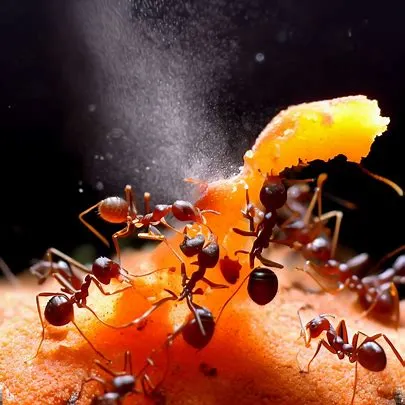Harnessing Nature's Arsenal: How Orange Peels Can Defeat Ant Infestations through Fungal Warfare
Ant infestations are a common nuisance that can disrupt the harmony of our homes and gardens. Traditional methods of ant control often involve chemical-laden pesticides that can pose risks to our health and the environment. However, a natural and innovative solution has emerged from an unexpected source: orange peels. In this article, we will delve into the fascinating world of using orange peels to combat ant infestations by harnessing the power of fungi.
The Intriguing Relationship Between Ants and Fungi
Before we dive into the details of how orange peels can be used to eradicate ants, it's essential to understand the complex relationship between ants and fungi. Certain species of ants have a remarkable interaction with fungi, known as fungiculture. These ants cultivate fungi in their nests as a food source, and the fungi thrive on organic material brought into the nest by the ants. This mutually beneficial relationship has evolved over millions of years, with both ants and fungi depending on each other for survival.
The Role of Orange Peels
Enter the humble orange peel, an everyday item found in most households. Orange peels contain natural compounds that can act as a powerful weapon against ants, particularly those engaged in fungiculture. These compounds have been found to possess antifungal properties, disrupting the delicate balance within ant colonies and ultimately leading to their demise.

Using Orange Peels to Infect Ant Nests
Here's how the process works:
- Collection: Start by collecting a sufficient quantity of orange peels. These can be fresh or dried, but dried peels are easier to work with and have a concentrated effect.
- Processing: Grind or blend the orange peels into a fine powder. This increases the surface area and allows for better distribution of the active compounds.
- Application: Sprinkle the powdered orange peels near ant trails and entry points. Ants are naturally attracted to the scent of orange peels, which disguises the powder's antifungal properties.
- Nest Penetration: As ants carry the powdered peels into their nests, the antifungal compounds begin to infiltrate the fungal colonies being cultivated by the ants.
- Fungal Devastation: The antifungal properties of the orange peels disrupt the growth and development of the cultivated fungi within the ant nest. This disruption weakens the ants' primary food source and destabilizes the colony.
- Colony Collapse: Over time, as the ant colony becomes increasingly unable to sustain itself due to the loss of their fungal food source, the colony collapses, leading to the effective elimination of the infestation.
Why Choose Orange Peels?
Using orange peels to combat ant infestations offers several distinct advantages:
- Eco-Friendly: Orange peels are a natural, biodegradable solution that poses minimal risk to the environment, pets, and humans.
- Non-Toxic: Unlike chemical pesticides, orange peels do not leave harmful residues behind and do not contribute to indoor air pollution.
- Sustainable: Orange peels are a readily available waste product that can be repurposed for effective ant control, reducing waste and promoting sustainability.
- Targeted Action: By specifically targeting ants engaged in fungiculture, orange peels provide a focused approach to ant infestation eradication.
Conclusion
The use of orange peels to combat ant infestations by infecting their nests with fungi is a remarkable example of nature's ingenuity harnessed for pest control. By leveraging the ant-fungus relationship, we can effectively disrupt the delicate balance within ant colonies and bring about their collapse in an eco-friendly and sustainable manner. As we strive to find innovative solutions to common challenges, orange peels stand as a testament to the power of natural remedies in our ongoing quest for harmony between humans and the environment.


